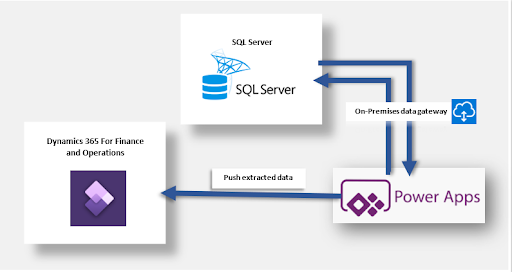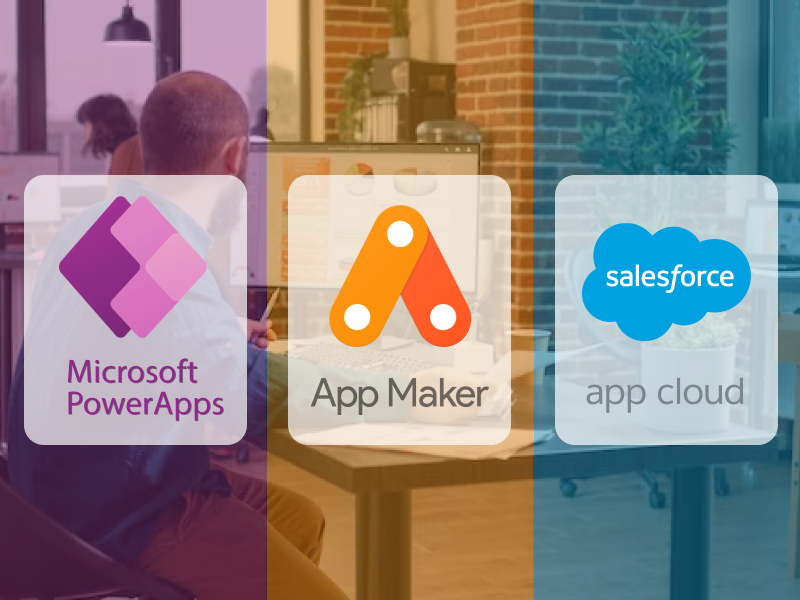Productivity is the key to success in today’s fast-paced, digitally advanced world. We all strive to work smarter, not harder, and that’s where the right tools and technologies come into play. In this ever-evolving landscape of remote work and flexible schedules, it’s crucial to stay equipped with the latest solutions to streamline your workflow and supercharge your business.
Enter Microsoft Power Apps—the ultimate solution that empowers you to easily build custom business applications, even if you’re not a programming expert. With its low-code platform, you can unleash your creativity and bring your ideas to life without getting tangled up in complex code.
In this blog, we will explore the power of Power Apps via its top features that can turbocharge your workflow and boost productivity, as well as the latest industry trends and Power Apps examples to keep you ahead of the curve.
Top 5 Features Of Power Apps for Productivity
1) Data integration
Data integration facilitates connecting and unifying data from numerous sources into an application. This feature eliminates the process of manually entering data into the app and ensures data accuracy is maintained by extracting it from its origin.
img src: Google
Let’s take an example of a company:
For businesses operating multiple software applications, such as Customer Relationship Management, Accounting, and Inventory Management, access to the databases of information they contain is essential.
With the power of Power Apps, a data integration feature allows these sources to be combined into a single location, creating an app to consolidate data. For instance, the app can comprehensively view a customer’s history, current balance, and inventory levels.
In addition, the app can keep data in real-time, meaning that any changes an employee makes to a customer’s account in the app will immediately reflect in the accounting software database. This allows for data maintenance across all applications and guarantees it is up-to-date and consistent.
Get free consultation and let us know your project idea to turn it into an amazing digital product.
2) Automation
It allows users to automate repetitive tasks and processes within their apps. This feature saves time & effort by eliminating the need to perform manual tasks and ensures consistency and accuracy in the execution of these tasks.
PowerApps examples:
Suppose a company uses an app to track employee attendance. Each day, an HR representative must manually input attendance data into the app, which can be time-consuming and tedious. With Power Apps’ automation feature, the attendance data gets automatically input into the app based on a pre-defined set of rules.
Moreover, the app can automatically update attendance data when employees swipe their ID badge at the office entrance. The app can also email the HR representative if an employee is absent over a specified number of days. This reduces manual data entry and allows the HR representative to focus on more strategic tasks.
For instance, an HR representative can create a workflow that automatically sends an email to the employee’s manager when the employee requests time off. The manager can approve or deny the request directly from their email inbox. Furthermore, the automation feature can integrate with other Microsoft products, such as Power Automate, allowing users to create complex workflows that span multiple applications.
3) Custom workflows
Custom workflows make users capable enough to craft their processes and workflows within their applications. This feature optimizes business operations by automating them, reducing mistakes, and maintaining uniformity in executions.
Img src: Google
PowerApps examples:
Suppose a company can streamline its sales process by leveraging Power Apps’ custom workflows feature. The process can be automated based on pre-defined rules rather than manually updating information for each new lead and scheduling a meeting.
Moreover, the app can automatically assign the lead to a specific sales representative based on geographic location or industry. The app can also email the sales representative information about the lead, including their contact information and any relevant notes from previous interactions.
When a meeting is booked, the app sends a calendar invite to the lead and the sales rep. After the meeting, it generates a follow-up task for the sales rep, which helps reduce manual labor and allows the rep to dedicate more time to developing connections with leads. All this becomes possible using PowerApps Development.
Also Read: How Power BI and OLAP Cubes Improve Your Business
4) Mobile access
It significantly increases productivity by giving users access to their apps on mobile devices. They can keep up with their apps and data from anywhere, thus staying connected and accomplishing tasks no matter where they are.
PowerApps examples:
Imagine a business using an application to regulate its stock. The power of Power apps feature allows employees to check stock levels, make orders and monitor shipments from anywhere. This aids workers in providing prompt replies to customers and controlling stock levels in real-time, boosting customer satisfaction and lowering the chances of a stock-out.
Moreover, the mobile access feature allows personnel to utilize the app’s data and functionality without an internet connection. Power Apps offers native application backing for iOS and Android gadgets, allowing clients to download and install the application from the app store, resulting in a smooth user experience, making it easy to access and use the application on their mobile devices.
5) Reporting and analytics
Utilizing an app’s reporting and analytics feature can dramatically reduce the time to generate reports, draw out real-time insights, and aid in data-driven decision-making.
Img src: Google
PowerApps examples:
Suppose a company that employs an app to monitor its sales can utilize the reporting and analytics feature of Power Apps to generate reports with real-time insights into their sales figures.
By leveraging Business Intelligence & Analytics Solutions, they can spot trends, assess performance, and make informed decisions for upgrading their sales operations.
For instance, the app can generate a report showing the overall sales revenue divided into a product category, sales rep, and geographic location, which can be narrowed down by date range, customer type, or other variables for an in-depth overview of the sales performance.
This lets users spot their highest-performing products, sales personnel, and geographic regions and make data-based conclusions to improve their sales process.
Furthermore, the reporting and analytics feature of Power Apps allows users to set up custom dashboards that present their key performance indicators (KPIs) in real time.
In the end, the reporting and analysis feature in Power Apps can bolster productivity by granting real-time insights into data and enabling data-based decisions. It allows users to create custom reports, design custom dashboards, and analyze data to improve business practices and secure more desirable outcomes.
Latest Industry Trends for Productivity
The latest industry trends refer to the best practices and strategies businesses adopt to improve their efficiency and output. Here we have listed some of the latest trends in productivity, their benefits & examples:
Automation and AI-powered tools
Automation and AI-powered tools streamline business processes and reduce manual work. Businesses can save time and improve efficiency by automating repetitive tasks.
Benefits of AI-powered tools:
- Make more accurate predictions
- Predict customer behavior
- Suggest actions to optimize operations.
Examples:
Robotic Process Automation: It uses software robots to automate repetitive, rule-based tasks such as data entry, invoice processing, and customer service.
Chatbots: It uses AI to provide automated customer service and support. Chatbots can handle a high volume of inquiries quickly and accurately. It reduces the workload on human customer service representatives.
Also Read: The Game-changing Integration of Power Apps & Dynamics 365
Cloud-based solutions
Cloud-based solutions enable teams to collaborate and access data from anywhere. This trend is particularly beneficial for remote teams or companies with multiple locations. Moreover, teams can work more efficiently, improve data security, and reduce communication delays using these solutions.
Examples:
Software as a Service: With Software as a Service (SAAS), users can access various software programs via the Internet. Subscribers of this type of service can use Salesforce for their customer relationship management, Dropbox for their cloud storage needs, and Microsoft 365 for productive purposes.
Platform as a Service: With PAAS, you can build, test, and publish software solutions utilizing resources like Google App Engine and Amazon Web Services.
Get free consultation and let us know your project idea to turn it into an amazing digital product.
Data-driven decision-making
Organizations today put a great emphasis on data-driven choices. These decisions aid them in detecting fresh prospects and discerning their customers’ needs. By leveraging analytics and reporting applications, they gain a comprehensive view of their activities and strengthen them.
Examples:
Customer data for marketing and sales strategies: By studying customer habits, such as what they purchase, what they look for online, and their background information, companies can adjust their advertising campaigns to target specific customer sets, maximizing their promotional success.
Data analytics for optimizing business operations: This method enhances effectiveness and cuts costs by detecting hindrances and delays in the supply chain.
Mobile-Friendly Solutions
Businesses are adopting mobile-friendly solutions due to the increasing use of mobile devices in the workplace. This enables employees to access data and apps from anywhere. This trend allows employees to work flexibly and stay connected, improving collaboration and productivity.
Examples:
Enterprise resource planning apps: These applications allow staff to acquire primary data regarding inventory, sales, and customer data through their cellular devices. This allows them to make sound judgments and rapidly adjust to altering business needs.
Mobile-enabled collaboration tools: Remote employees can keep in touch with each other, exchange documents, and cooperate on projects using Slack and Microsoft Teams on their smartphones.
Customization
As the competition increases, businesses strive to stand out by creating custom solutions that satisfy their client’s unique requirements. Customization permits them to tailor their answers to the peculiarities of their processes, data structures, and workflows, ultimately helping them to provide personalized experiences.
Examples:
Use of product configurators: Customers can tailor their desired product with options like hue, design, and components with the help of these online tools.
Use of personalized marketing campaigns: Companies can personalize their advertising campaigns to suit each customer based on their choices, inclinations, and actions, achieved by gathering and examining data related to the customers.
Businesses can optimize their operations and gain a competitive advantage by adopting the above trends. The power of Power Apps incorporates many of these trends, making it a powerful tool for improving productivity and achieving business goals.
Get free consultation and let us know your project idea to turn it into an amazing digital product.
Combining Power Apps Features with Industry Trends
Combining the power of Power Apps features with industry trends refers to using the latest productivity strategies and best practices to get the most out of the features available in Power Apps. Hence, businesses can achieve great collaboration, higher efficiency, and productivity levels if they do so.
Leveraging its automation features, such as custom workflows, and the increasing industrial use of AI-driven tools will enable them to automate time-consuming processes such as data entry and document routing.
Moreover, AI can forecast potential outcomes and propose the best possible actions. A business seeking to reduce manual work can look to Power Apps to help them achieve this goal.
Businesses can bolster collaboration and flexibility by incorporating Power Apps’ mobile access capabilities and taking advantage of the popular trend of cloud-based solutions. With this combination, personnel can access data and applications from any location anytime, aiding remote personnel to work effectively and remain in contact.
Businesses that want to be strategic and gain operational efficiency can combine Power Apps’ reporting and analytics features with the industry trend of data-driven decision-making. This combination empowers them to analyze data instantly, generating personalized reports which offer deeper insights, aiding them to make informed choices.
By combining the power of Power Apps features with industry trends, businesses can create tailored solutions that fit their needs and processes. This can result in significant productivity gains, cost savings, and competitive advantages.
Conclusion
So we have seen how the Power Apps has become an indispensable tool for streamlining workflows and automating processes in today’s workplace. Its user-friendly interface and advantageous features have entirely transformed how companies work, making productivity a critical element of organizational success.
As low-code solutions and collaboration take on an ever-greater importance, Power Apps stands poised to become even more critical in the years ahead. Organizations and individuals alike can supercharge their processes and maximize efficiency by tapping into their potential and keeping up with the latest advances.
You can outsource our BI Implementation Services from ValueCoders to turbocharge your business workflow. We are the leading Power BI Development Services company in India since 2004. Connect with us today!



















